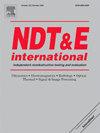基于物理信息神经网络的混凝土板超声缺陷检测
IF 4.1
2区 材料科学
Q1 MATERIALS SCIENCE, CHARACTERIZATION & TESTING
引用次数: 0
摘要
由于混凝土本身的非均匀性,使得材料性能的空间表征复杂化,传统的无损检测(NDT)方法面临着准确评估混凝土的挑战。为了解决这些限制,这项工作考虑了物理信息神经网络(pinn)来解释非接触式超声波扫描数据,以增强混凝土中的缺陷检测能力。pinn通过数学控制方程将物理定律集成到人工神经网络模型中,以克服纯数据驱动分析方法的局限性。本研究使用的实验数据来自含夹杂物的大型混凝土板、带裂缝的冷接缝和表面火灾损伤,以及均质PMMA板(作为参考)。利用一个简单的时域波场数据集,利用所提取的控制波动方程的系数,将PINN结果用于创建与空间相关的属性映射。结果表明,pin - ns可以有效地预测与空间相关的波速。这种方法有助于准确的材料性能表征和缺陷识别。所提出的PINN模型对PMMA板的p波速度预测误差为0.34%,对混凝土板缺陷的面积范围进行识别,对原始区域的误差为1%,对夹杂区域的误差为2.1%。从预测的波速图中检测到夹杂区域周围亚波长大小的裂纹。这些发现表明,pinn为提高混凝土结构缺陷检测的准确性和效率提供了一种有希望的方法,其空间分辨率优于其他传统超声成像方法。本文章由计算机程序翻译,如有差异,请以英文原文为准。
Ultrasonic defect detection in a concrete slab assisted by physics-informed neural networks
Traditional nondestructive testing (NDT) methods face challenges to accurately assess concrete owing to its naturally inhomogeneous nature that complicates spatial characterization of material properties. To address these limitations, this work considers physics-informed neural networks (PINNs) interpreting contactless ultrasonic scan data to enhance defect detection capabilities in concrete. PINNs integrate physics laws through mathematical governing equations into artificial neural network models to overcome limitations of purely data-driven analysis approaches. The study utilizes experimental data collected from a large-scale concrete slab containing inclusion, cold joints with cracks, and surface fire damage and from a homogeneous PMMA slab (as a reference). The PINN results are used to create space-dependent property maps based on the extracted coefficient of the governing wave equation using a simple time-domain wavefield data set. The results demonstrate that PINNs effectively predict space-dependent wave velocities. This approach facilitates accurate material property characterization and defect identification. The proposed PINN models achieved a P-wave velocity prediction error of 0.34 % for the PMMA slab and identified areal extent of defects in the concrete slab with errors of 1 % for pristine areas and 2.1 % for inclusion areas. Sub-wavelength-sized cracks around the inclusion areas were detected from the predicted wave velocity map. These findings suggest that PINNs offer a promising approach for improving the accuracy and efficiency of defect detection in concrete structures with superior spatial resolution provided by other conventional ultrasonic imaging approaches.
求助全文
通过发布文献求助,成功后即可免费获取论文全文。
去求助
来源期刊

Ndt & E International
工程技术-材料科学:表征与测试
CiteScore
7.20
自引率
9.50%
发文量
121
审稿时长
55 days
期刊介绍:
NDT&E international publishes peer-reviewed results of original research and development in all categories of the fields of nondestructive testing and evaluation including ultrasonics, electromagnetics, radiography, optical and thermal methods. In addition to traditional NDE topics, the emerging technology area of inspection of civil structures and materials is also emphasized. The journal publishes original papers on research and development of new inspection techniques and methods, as well as on novel and innovative applications of established methods. Papers on NDE sensors and their applications both for inspection and process control, as well as papers describing novel NDE systems for structural health monitoring and their performance in industrial settings are also considered. Other regular features include international news, new equipment and a calendar of forthcoming worldwide meetings. This journal is listed in Current Contents.
 求助内容:
求助内容: 应助结果提醒方式:
应助结果提醒方式:


